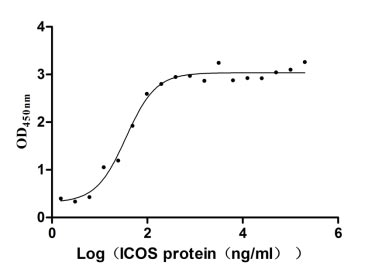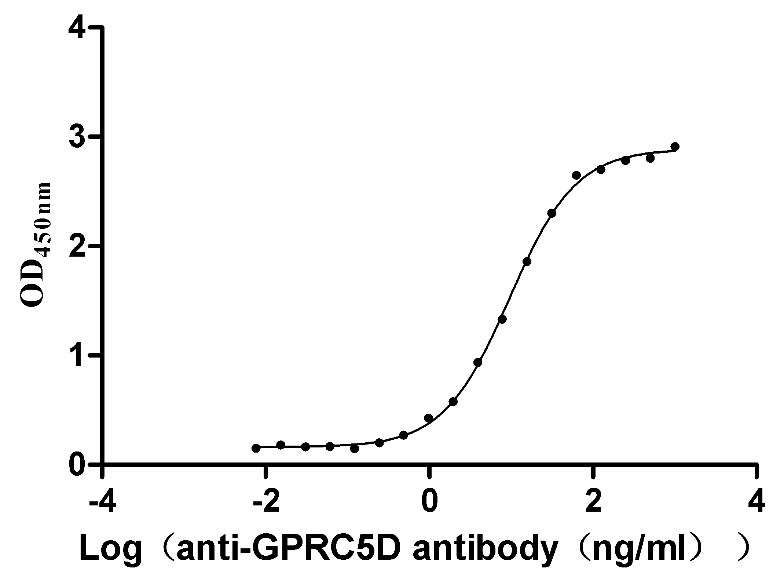Recombinant Mouse Myocyte-specific enhancer factor 2A (Mef2a)
-
货号:CSB-YP726688MO
-
规格:
-
来源:Yeast
-
其他:
-
货号:CSB-EP726688MO
-
规格:
-
来源:E.coli
-
其他:
-
货号:CSB-EP726688MO-B
-
规格:
-
来源:E.coli
-
共轭:Avi-tag Biotinylated
E. coli biotin ligase (BirA) is highly specific in covalently attaching biotin to the 15 amino acid AviTag peptide. This recombinant protein was biotinylated in vivo by AviTag-BirA technology, which method is BriA catalyzes amide linkage between the biotin and the specific lysine of the AviTag.
-
其他:
-
货号:CSB-BP726688MO
-
规格:
-
来源:Baculovirus
-
其他:
-
货号:CSB-MP726688MO
-
规格:
-
来源:Mammalian cell
-
其他:
产品详情
-
纯度:>85% (SDS-PAGE)
-
基因名:
-
Uniprot No.:
-
别名:Mef2a; Myocyte-specific enhancer factor 2A
-
种属:Mus musculus (Mouse)
-
蛋白长度:full length protein
-
表达区域:1-498
-
氨基酸序列MGRKKIQITR IMDERNRQVT FTKRKFGLMK KAYELSVLCD CEIALIIFNS SNKLFQYAST DMDKVLLKYT EYNEPHESRT NSDIVETLRK KGLNGCESPD ADDYFEHSPL SEDRFSKLNE DSDFIFKRGP PGLPPQNFSM SVTVPVTSPN ALSYTNPGSS LVSPSLAASS TLADSSMLSP PPATLHRNVS PGAPQRPPST GSASGMLSTT DLTVPNGAGN SPVGNGFVNS RASPNLIGNT GANSLGKVMP TKSPPPPGGG SLGMNSRKPD LRVVIPPSSK GMMPPLSEEE ELELNAQRIS SSQATQPLAT PVVSVTTPSL PPQGLVYSAM PTAYNTDYSL TSADLSALQG FTSPGMLSLG QASAWQQHHL GQAALSSLVA GGQLSQGSNL SINTNQNINI KSEPISPPRD RMTPSGFQQQ QQQPQQQPPP QPPQPQPRQE MGRSPVDSLS SSSSSYDGSD REDPRGDFHS PIVLGRPPNT EDRESPSVKR MRMDTWVT
-
蛋白标签:Tag type will be determined during the manufacturing process.
The tag type will be determined during production process. If you have specified tag type, please tell us and we will develop the specified tag preferentially. -
产品提供形式:Lyophilized powder
Note: We will preferentially ship the format that we have in stock, however, if you have any special requirement for the format, please remark your requirement when placing the order, we will prepare according to your demand. -
复溶:We recommend that this vial be briefly centrifuged prior to opening to bring the contents to the bottom. Please reconstitute protein in deionized sterile water to a concentration of 0.1-1.0 mg/mL.We recommend to add 5-50% of glycerol (final concentration) and aliquot for long-term storage at -20℃/-80℃. Our default final concentration of glycerol is 50%. Customers could use it as reference.
-
储存条件:Store at -20°C/-80°C upon receipt, aliquoting is necessary for mutiple use. Avoid repeated freeze-thaw cycles.
-
保质期:The shelf life is related to many factors, storage state, buffer ingredients, storage temperature and the stability of the protein itself.
Generally, the shelf life of liquid form is 6 months at -20°C/-80°C. The shelf life of lyophilized form is 12 months at -20°C/-80°C. -
货期:Delivery time may differ from different purchasing way or location, please kindly consult your local distributors for specific delivery time.Note: All of our proteins are default shipped with normal blue ice packs, if you request to ship with dry ice, please communicate with us in advance and extra fees will be charged.
-
注意事项:Repeated freezing and thawing is not recommended. Store working aliquots at 4°C for up to one week.
-
Datasheet :Please contact us to get it.
靶点详情
-
功能:Transcriptional activator which binds specifically to the MEF2 element, 5'-YTA[AT](4)TAR-3', found in numerous muscle-specific genes. Also involved in the activation of numerous growth factor- and stress-induced genes. Mediates cellular functions not only in skeletal and cardiac muscle development, but also in neuronal differentiation and survival. Plays diverse roles in the control of cell growth, survival and apoptosis via p38 MAPK signaling in muscle-specific and/or growth factor-related transcription. In cerebellar granule neurons, phosphorylated and sumoylated MEF2A represses transcription of NUR77 promoting synaptic differentiation. Associates with chromatin to the ZNF16 promoter.
-
基因功能参考文献:
- Canonical pathway analysis of genes preferentially dysregulated in the atria and ventricles revealed distinct MEF2A-dependent cellular processes in each cardiac chamber. In the atria, MEF2A regulated genes involved in fibrosis and adhesion, whereas in the ventricles, it controlled inflammation and endocytosis. PMID: 29054930
- Both synapse silencing and elimination required de novo transcription, but only silencing required the activity-dependent transcription factors MEF2A/D. PMID: 28901289
- Deficiency of AKT2 in myocardium results in diminished MEF2A abundance, which induced decreased size of cardiomyocytes. We additionally confirmed that EndoG, which is also regulated by AKT2, is a suppressor of MEF2A in myocardium. PMID: 28965945
- Nuclear HDAC4 binds to chromatin as well as to MEF2A transcription factor, leading to histone deacetylation and altered neuronal gene expression. By using a Cdkl5 knockout (Cdkl5 -/Y) mouse model, we found that hypophosphorylated HDAC4 translocates to the nucleus of neural precursor cells, thereby reducing histone 3 acetylation. PMID: 27466189
- Knockdown of MEF2A significantly reduced hyperglycemia-induced cardiac fibroblast proliferation and migration, myofibroblast differentiation, matrix metalloproteinase activities, and collagen production. PMID: 26482596
- Lentivirus-mediated MEF 2A shRNA accelerates inflammation and atherosclerosis in APOE knockout mice, but has no effect on lipoprotein levels in plasma. PMID: 25793529
- microRNAs encoded by the Gtl2-Dio3 noncoding RNA locus function downstream of the MEF2A PMID: 26240138
- Our results indicated that exercise-induced CPT1b expression was at least in part mediated by HDAC5/MEF2A interaction. PMID: 25213552
- MEF2A is targeted to lysosomes for chaperone-mediated autophagy degradation; oxidative stress-induced lysosome destabilization leads to the disruption of MEF2A degradation as well as the dysregulation of its function PMID: 24879151
- Whereas MEF2A is absolutely required for proper myoblast differentiation, MEF2B, -C, and -D were found to be dispensable for this process. PMID: 25416778
- A role for endogenous MEF2 factors exclusively in hormone/Fsk/cAMP-induced Nr4a1 gene expression in mouse MA-10 Leydig cells. PMID: 24694307
- Combined deletion of the Mef2a, c, and d genes results in a blockade to muscle regeneration. PMID: 24591619
- Cross-talk between p38MAPK and GSK3beta signaling converges on MEF2 activity. PMID: 23137781
- Myocyte enhancer factor 2A (MEF2A) controls skeletal muscle regeneration in adult mice through direct regulation of the largest known mammalian microRNA (miRNA) cluster, the Gtl2-Dio3 locus. PMID: 23154418
- These results give novel insight into the molecular interplay of GR and MEF2 in the control of genes important for neuronal plasticity. PMID: 22622902
- MEF2A, but not MEF2C or MEF2D, is modified by ubiquitination in dopaminergic neuronal cell line SN4741 cells. PMID: 22764880
- The data highlighted the key in vivo role of MEF2C isoform in the brain and suggest that MEF2A and MEF2D have only subtle roles in regulating hippocampal synaptic function. PMID: 22496871
- establish miR-155 as an important regulator of MEF2A expression and uncover its function in muscle gene expression and myogenic differentiation. PMID: 21868385
- Exercise increases the nuclear MEF2A content and binding of MEF2A to their binding sites on the Glut4 gene by an AMPKalpha2-dependent mechanism. PMID: 21233771
- The Mef2A transcription factor coordinately regulates a costamere gene program in cardiac muscle. PMID: 21724844
- A systems biology study integrating mRNA profiles with DNA-binding events of key cardiac transcription factors (Gata4, Mef2a, Nkx2.5, and Srf), activating histone modifications (H3ac, H4ac, H3K4me2, and H3K4me3), and microRNA profiles, is reported. PMID: 21379568
- ZAC1 is a novel and previously unknown regulator of cardiomyocyte Glut4 expression and glucose uptake; MEF2 is a regulator of ZAC1 expression in response to induction of hypertrophy PMID: 20363751
- active MEF2 and fragile X mental retardation protein function together in an acute, cell-autonomous mechanism to eliminate excitatory synapses. PMID: 20434996
- Reveal a novel MEF2A-Xirp2 pathway that functions downstream of Ang II signaling to modulate its pathological effects in the heart. PMID: 20093629
- TGF-beta transcriptionally upregulated MMP-10 through activation of MEF2A, concomitant with acetylation of core histones increasing around the promoter, as a consequence of degradation of the class IIa HDACs. PMID: 19935709
- Dermo-1, a multifunctional basic helix-loop-helix protein, represses MyoD transactivation via the HLH domain, MEF2 interaction, and chromatin deacetylation PMID: 11809751
- deficient mice suffered sudden cardiac death PMID: 12379849
- MEF2A expression is regulated by BMP-2-induced PI 3-kinase signaling PMID: 12663654
- Calcineurein regulates skeletal muscle differentiation by activating MEF2 and MyoD transcription factors. PMID: 12694204
- MEF2 has a role in maintaining GLUT4 in adult muscle and cooperates with MyoD transcription factors and thyroid hormone receptors in regulating GLUT4 in regenerating muscle PMID: 12893821
- GEF and MEF2A have roles in regulating the GLUT4 promoter PMID: 14630949
- MEF2A is induced by CUGPB-1 and along with p21, it inhibits myogenesis and contributes to the development of muscle deficiency myotonic dystrophy PMID: 14722059
- Data show that static stretch application produces a robust increase in p38 phosphorylation preceding MEF2A, but not NFATc1, nuclear translocation. PMID: 15483225
- MEF2 has a role in regulating genes during muscle differentiation PMID: 15507520
- Myocyte enhancer factor-2 and serum response factor binding elements regulate fast Myosin heavy chain transcription in vivo PMID: 15728583
- A conserved pattern of alternative splicing in vertebrate MEF2 (myocyte enhancer factor 2) genes generates an acidic activation domain in MEF2 proteins selectively in tissues where MEF2 target genes are highly expressed. (MEF2) PMID: 15834131
- MEF2/HAND1 interaction results in synergistic activation of MEF2-dependent promoters, and MEF2 binding sites are sufficient to mediate this synergy PMID: 16043483
- MEF2A up-regulates myospryn at the costamere in striated muscle potentially playing a role in myofibrillogenesis. PMID: 16407236
- MEF2 transcription factors in the postnatal heart activate a genetic program that minimally affects cardiac growth yet promotes chamber dilation, mechanical dysfunction, and dilated cardiomyopathy. PMID: 16847152
- Myomaxin functions directly downstream of MEF2A at the peripheral Z-disc complex in striated muscle potentially playing a role in regulating cytoarchitectural integrity PMID: 17046827
- Differences in GLUT4 transcription when whole adipose tissue and cell culture model systems are compared can be correlated to a posttranslational phosphorylation of the transcription factor MEF2A. PMID: 17164432
- ataxin-1 antagonizes the neuronal survival function of myocyte enhancer factor-2 PMID: 17646162
- SOST expression in osteocytes of adult bone and its inhibition by PTH is mediated by MEF2A, C, and D transcription factors controlling the SOST bone enhancer. PMID: 17696759
- MEF2 has a central role as a regulator of the transcriptional and posttranscriptional pathways that control cardiac and skeletal muscle development PMID: 18093911
- GLUT4 enhancer factor (GEF) interacts with MEF2A and HDAC5 to regulate the GLUT4 promoter in adipocytes. PMID: 18216015
- These findings support a role for MEF2A as an intermediary in coordinating respiratory chain subunit expression in heart and muscle through a NRF1 --> MEF2A --> COX(H) transcriptional cascade. PMID: 18222924
- miR-1 regulates cardiomyocyte growth responses by negatively regulating the calcium signaling components calmodulin, Mef2a, and Gata4 PMID: 19188439
显示更多
收起更多
-
亚细胞定位:Nucleus.
-
蛋白家族:MEF2 family
-
组织特异性:Widely expressed though mainly restricted to skeletal and cardiac muscle, brain, neurons and lymphocytes. Differentially expressed depending on if isoforms contain the beta domain or not, with the total expression of the beta domain-lacking isoforms vastl
-
数据库链接:
KEGG: mmu:17258
STRING: 10090.ENSMUSP00000117496
UniGene: Mm.132788
Most popular with customers
-
Recombinant Human ICOS ligand (ICOSLG), partial (Active)
Express system: Mammalian cell
Species: Homo sapiens (Human)
-
Recombinant Human HLA class II histocompatibility antigen gamma chain (CD74), partial (Active)
Express system: Mammalian cell
Species: Homo sapiens (Human)
-
Recombinant Human IGF-like family receptor 1 (IGFLR1), partial (Active)
Express system: Mammalian cell
Species: Homo sapiens (Human)
-
Recombinant Human G-protein coupled receptor family C group 5 member D (GPRC5D)-VLPs (Active)
Express system: Mammalian cell
Species: Homo sapiens (Human)
-
Recombinant Human Somatostatin receptor type 2 (SSTR2)-VLPs (Active)
Express system: Mammalian cell
Species: Homo sapiens (Human)
-
Recombinant Human B- and T-lymphocyte attenuator(BTLA), partial (Active)
Express system: Mammalian cell
Species: Homo sapiens (Human)
-
Recombinant Human Kidney-associated antigen 1(KAAG1) (Active)
Express system: E.coli
Species: Homo sapiens (Human)
-
Recombinant Macaca fascicularis Zinc transporter ZIP6 isoform X1(SLC39A6),partial (Active)
Express system: Baculovirus
Species: Macaca fascicularis (Crab-eating macaque) (Cynomolgus monkey)



-AC1.jpg)
















